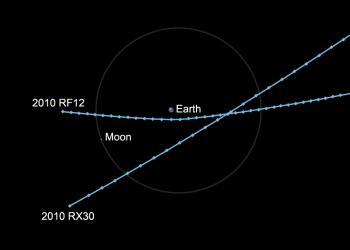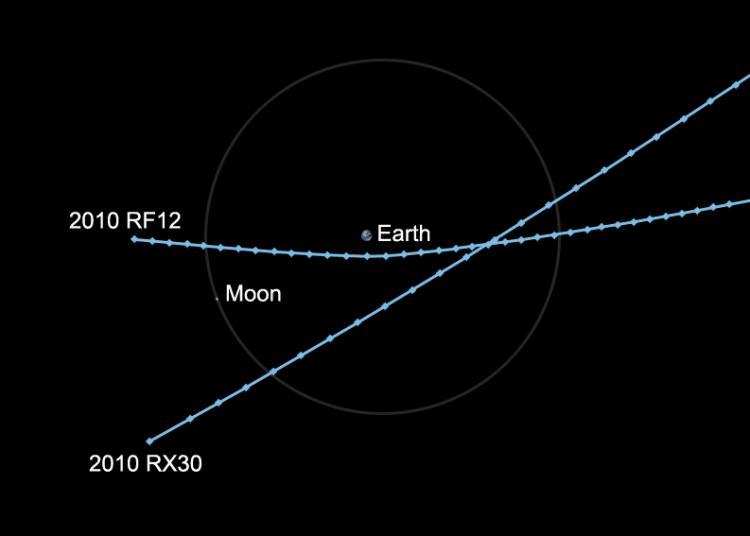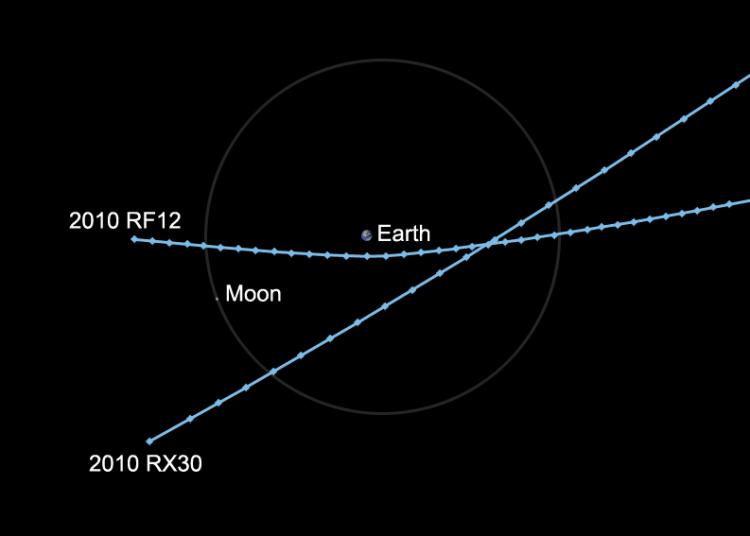Two small asteroids, 2010 RF12 and 2010 RX30, will pass across the Earth’s sky on Wednesday September 8, NASA announced. Both will be visible with amateur telescopes upon their nearest approach to our planet. However, there is no chance the objects will hit soil.
The two asteroids were first detected by The Catalina Sky Survey near Tucson, Arizona on Sunday morning. Later The Minor Planet Center in Cambridge, Massachusetts, assessed the asteroids’ orbits and concluded they would pass at a lunar distance three days later.
One of the asteroids called 2010 RX30 and has an estimated size of 32 to 65 feet, (10 to 20 meters) flew by the Earth at a distance of approximately 154,000 miles (248,000 kilometers) and was visible in the sky around 2:51 a.m. PDT (5:51 a.m. EDT). The second one, bearing the name 2010 RF12, will be a little bigger—20 to 46 feet (6 to 14 meters), passing at 49,088 miles (79,000 kilometers) from us and will be observable later, at around 2:12 p.m. PDT (5:12 pm EDT), according to NASA.
NASA expects that a ten-meter-sized asteroid, out of a total of 50 million asteroids, might approach the Earth every ten years, at the same distance from the Earth as the moon; some may pass through the Earth’s atmosphere at the most.
As of May 2010, 7,075 near-Earth asteroids are known, ranging in size up to 19.8 miles (32 kilometers) diameter. The number of near-Earth asteroids with a size of over one kilometer in diameter is estimated to be 500 - 1,000, according to NASA statistics. The composition of near-Earth asteroids is comparable to that of asteroids from the main asteroid belt, reflecting a variety of asteroid spectral types.
The largest asteroid by far is 1-Ceres, with a size of 605 miles (974 kilometers) in diameter. The next largest are the 2-Pallas, 4-Vesta and 10-Hygiea asteroids ranging between 268 miles (430 kilometers) and 338 miles (544 kilometers) average diameter. All other known asteroids are less than 220 miles (354 kilometers) across.
The two asteroids were first detected by The Catalina Sky Survey near Tucson, Arizona on Sunday morning. Later The Minor Planet Center in Cambridge, Massachusetts, assessed the asteroids’ orbits and concluded they would pass at a lunar distance three days later.
One of the asteroids called 2010 RX30 and has an estimated size of 32 to 65 feet, (10 to 20 meters) flew by the Earth at a distance of approximately 154,000 miles (248,000 kilometers) and was visible in the sky around 2:51 a.m. PDT (5:51 a.m. EDT). The second one, bearing the name 2010 RF12, will be a little bigger—20 to 46 feet (6 to 14 meters), passing at 49,088 miles (79,000 kilometers) from us and will be observable later, at around 2:12 p.m. PDT (5:12 pm EDT), according to NASA.
NASA expects that a ten-meter-sized asteroid, out of a total of 50 million asteroids, might approach the Earth every ten years, at the same distance from the Earth as the moon; some may pass through the Earth’s atmosphere at the most.
As of May 2010, 7,075 near-Earth asteroids are known, ranging in size up to 19.8 miles (32 kilometers) diameter. The number of near-Earth asteroids with a size of over one kilometer in diameter is estimated to be 500 - 1,000, according to NASA statistics. The composition of near-Earth asteroids is comparable to that of asteroids from the main asteroid belt, reflecting a variety of asteroid spectral types.
The largest asteroid by far is 1-Ceres, with a size of 605 miles (974 kilometers) in diameter. The next largest are the 2-Pallas, 4-Vesta and 10-Hygiea asteroids ranging between 268 miles (430 kilometers) and 338 miles (544 kilometers) average diameter. All other known asteroids are less than 220 miles (354 kilometers) across.







